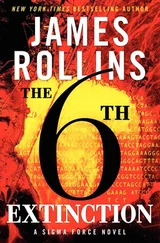Jim recognized the name. Yulong Xueshan wasn’t actually a single mountain, but a range of thirteen peaks in Yunnan Province. This, according to Arvin’s memories, was the location of Supreme Harmony’s headquarters, the Yunnan Operations Center. And as Jim stared at the Mandarin characters he knew with absolute certainty that this was where Supreme Harmony had taken his daughter.
He was still pondering the images of the mountain range and the underground laboratory when Kirsten slowed the scooter to a halt. “Okay, we’re at the southern end of the Changping tunnel,” she said. “This is the Underground City’s version of Grand Central Terminal.”
“Kir, I can’t see a thing.” Beyond the glow from the sat phone’s screen, the darkness was total.
“Right, I forgot. You can’t see infrared. We’re in a large circular room where six corridors branch off in different directions.”
“You’ve been here before?”
“Yeah, one of the corridors connects to the maze of tunnels under downtown Beijing. That’s where I came into the Underground City, through a condemned building on the Xidamo Hutong.”
“Can we get out of the tunnels that way without being spotted?”
“I noticed a few surveillance cameras along the hutong, and there’s probably more on the avenues nearby. But I think we can make a run for it. Xidamo is just a few miles from the American embassy. If I gun the scooter, we can be there in five minutes. Then all we have to do is get the flash drive to Washington and let the diplomats do the rest.”
Jim shook his head. “We won’t make it. There’s at least a hundred Beijing cops surrounding the embassy by now.”
“What makes you think—”
“Trust me on this, Kir. We’re the most wanted people in the People’s Republic.”
“Well, I suppose we can hide in the tunnels for a day or two, until the heat dies down. We can probably find some water. And I know where we can get some mushrooms.”
He shook his head again. He knew they couldn’t stay in the tunnels for very long. Supreme Harmony was too intelligent. The network had access to every computer and surveillance camera in Beijing. Sooner or later it would figure out where they were.
“Do you know where the other tunnels go?” Jim asked. “The ones that branch off from this room, I mean?”
“Yeah, the names of the districts are chiseled in the concrete. Besides the downtown and Changping, they go to Shunyi, Tongzhou, Daxing, and Fangshan.”
Jim plotted the route in his mind. The Fangshan District was in Beijing’s southwestern corner. If they were lucky, the tunnel’s exit would be similar to the exit for the Changping tunnel, in an isolated and unmonitored area. Once they emerged from the tunnel, they could take the back roads through the Taihang Mountains. Yunnan Province was fourteen hundred miles to the southwest, half a continent away. But that’s where they had to go.
“Head for Fangshan,” Jim said. “And go fast.”
Supreme Harmony observed the entrance to a rundown guesthouse in the Qinlao Hutong, approximately three kilometers north of Tiananmen Square. Module 51 knocked on the door while Modules 52 and 53 scanned the dark alley with their ocular cameras. All three Modules were formerly Guoanbu agents, and they still wore the black suits that were customary for their profession. They also wore gray caps to hide their stitches.
After twenty seconds, the door opened partway and an old woman poked her head outside. This was the manager of the guesthouse, the network surmised. Her wide eyes and frightened expression indicated that she recognized the Modules as government agents. Without a word, she opened the door all the way and let them inside.
The Modules marched down a narrow hallway that smelled of fried pork. The old woman pointed to a warped door at the end of the hall, and Module 51 examined the doorjamb and lock. They were of inferior construction. The human who’d sought refuge here had apparently assumed that no one would look for him in such dilapidated accommodations. But the surveillance cameras in the lobby of the Grand Hyatt Beijing had observed the man checking out of that hotel earlier in the evening, and the cameras on Chang’an Avenue and Beiheyan Street had followed his progress across the central districts of the capital. Because Supreme Harmony had been designed to analyze surveillance video from a variety of sources, it was a simple matter for the network to identify the man and track him to this inconspicuous guesthouse.
Module 51 pulled a 9mm semiautomatic from his holster and lifted his right knee, preparing to kick. Drawing on the skills honed by a dozen Guoanbu agents, the Module slammed his boot against the door and burst into the room, followed closely by Modules 52 and 53. The human lay half-dressed on a low bed. He bolted upright and reached for a Glock pistol resting on the mattress, but Module 51 directed a second kick at the man’s jaw. As the man tumbled backward against the wall, Module 51 grabbed the Glock. Meanwhile, Modules 52 and 53 aimed their guns at the man’s head. The threat had been neutralized. Now the interrogation could begin.
“We’ve confirmed your identity,” Module 51 said. “Your name is Franklin B. Nash.”
* * *
Approximately twenty kilometers to the northeast of the hutong, at Beijing Capital International Airport, Supreme Harmony observed the first-class section of Air China Flight 987. Modules 56 and 57 took their seats and fastened their seat belts and pretended to read the laminated pamphlets detailing the passenger-safety instructions. They wore casual clothes, like ordinary tourists, with baseball caps covering their newly shaved heads. The other passengers paid no attention to them, but the network noticed a flight attendant giving the Modules a sidelong glance as she walked down the aisle. Her expression indicated curiosity and possibly suspicion. In response, Supreme Harmony adjusted the behavior of the Modules to avoid the appearance of unnatural synchrony. While Module 56 continued to peruse the safety instructions, Module 57 put the pamphlet away and pretended to read the in-flight magazine instead.
Before their incorporation into the network, the Modules had been assigned to the Guoanbu’s Second Bureau, which sent agents overseas to spy on foreign governments. By now, Supreme Harmony had infiltrated all twelve bureaus of the Ministry of State Security, and the incorporation of Minister Deng Guoming had consolidated the network’s control of the intelligence agency. Unfortunately, Supreme Harmony had been less successful in penetrating the People’s Liberation Army and the other branches of the Chinese government. The military chiefs and Communist Party bosses were constantly surrounded by protective and suspicious aides, making it difficult for the network to gain access to the country’s paramount leaders.
Given enough time—maybe two weeks, maybe three—Supreme Harmony could isolate and incorporate the members of the Politburo Standing Committee, which would put China’s army and nuclear strike force under the network’s command. But the risks of waiting were too great. The disappearance of James T. Pierce had deeply disturbed Supreme Harmony. A review of government records and surveillance video showed that Pierce had entered the country with Kirsten W. Chan, a top official at the U.S. National Security Agency who had close ties to the NSA director. If Pierce passed his information about Supreme Harmony to Chan and she relayed it to her superiors, the American intelligence agency might recognize the danger and alert the Chinese government. What’s more, the network couldn’t pinpoint Chan’s current location, even though Supreme Harmony was now linked to all the surveillance cameras in Beijing. She was last observed nearly two hours ago by Camera 4983 in the Xidamo Hutong. The video showed her pushing a Baotian scooter down the alley.
Читать дальше












